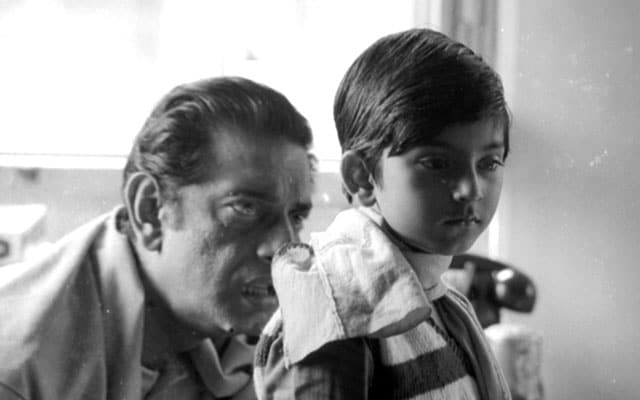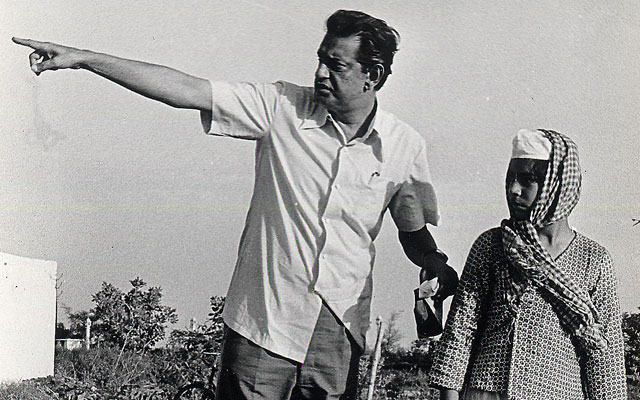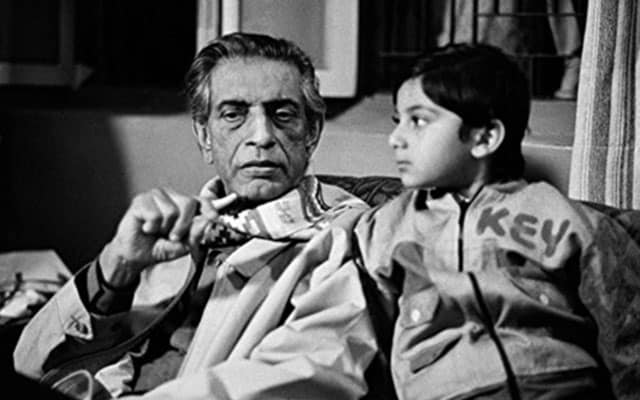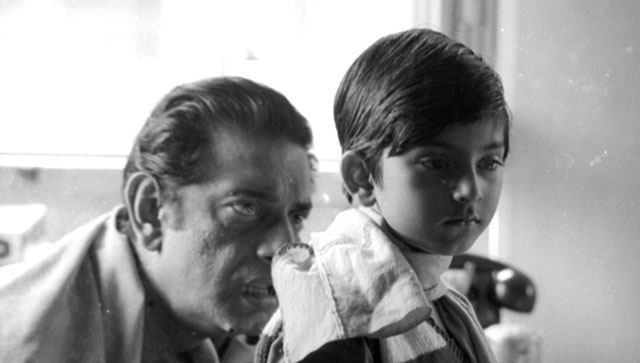Satyajit Ray’s equation with children was indescribably synergistic. This rapport began with his first film Pather Panchali (The Song of the Little Road) and lasted till his last creation, Agantuk (The Stranger). A span of almost four decades.
“A few children were playing near our first house on Lake Avenue (in south Calcutta). Amongst them, mother discovered one, Subirda (Banerjee), and called out to father to also take a look. Father also liked him and Subirda was asked over to our place so that both father and mother could interact with him and form a better assessment of the boy. In turn, permission was sought from the parents for Subirda to be cast as Apu in Pather Panchali. In turn, Umadi (Dasgupta) slipped into the role of Durga. Umadi can’t be described exactly as a child actor since she was in her teens,” reminisces Sandip, Satyajit Ray’s son and a film maker himself.
Uma Dasgupta was very intelligent and lapped up Ray’s direction effortlessly. But, Subir Banerjee, being much younger in age, had to be “coached” by Satyajit Ray as the master film maker went about filming Pather Panchali. “Father used to pass on a set of instructions to Subirda which paid off fruitfully during shots. He found that Subirda was reacting as desired to this approach. That method worked out well,” adds Sandip. Pather Panchali played out in this way and ended up being a magnum opus.
When it came to Aparajito (The Unvanquished), Pinaki Sengupta and Smaran Ghoshal acted out the younger Apu and older Apu respectively. Pinaki Sengupta used to frequent the Ray household quite often with his parents after he was cast as Apu.
Then, one saw a child artiste, a relatively non-descript character who was handed The Philosopher’s Stone (Paras Pathar) by Tulshi Chakraborty who later bribed him with goodies to get him to return the stone to Chakraborty when the latter realised it was the nothing but the unbelievable philosopher’s stone.
Then, Pinaki Sengupta returned to play Biswambar Ray’s (unforgettably enacted by Chhabi Biswas) son in Jalsaghar. “Father was extremely satisfied working with Pinakida in Aparajito. So, he brought him back again in Jalsaghar (The Music Room),” informs Sandip. Next, we witness little Kajol (Alok Chakravarty), Apu’s and Aparna’s (Soumitra Chatterjee and Sharmila Tagore) son in Apur Sansar, showing off his acting prowess with a little guidance from the auteur.
“In the sequence where Apu comes visiting Kajol for the first time and goes up to the terrace room to find Kajol sleeping, the child was actually cajoled to sleep in reality. Then, when Kajol wakes up, the boy gets out of slumber. That wasn’t play-acting. It was extremely spontaneous. I learnt this later from my mother,” reveals Sandip. This was probably only achievable by masters such as Satyajit Ray with a child of Alok Chakravarty’s age. “Besides, when Kajol takes off his mask (as he walks through the woodlands), his face created a stir in audiences. I haven’t learnt of any predicament being faced by father as far as Kajol goes.”
The next film that Ray made was Devi. Here Arpan Chowdhury played Khoka, the child who dies in the film because Dayamoyee (Sharmila Tagore) fails to cure him despite being revered as the living goddess. The film depicts conflicts arising in the wake of this tragedy.
In the first of Teen Kanya’s (The Three Daughters) three shorts, Postmaster saw Chandana Banerjee playing Ratan, the postmaster’s assistant. “Chandanadi was amazing in her performance and father’s casting her was bang on target. She delivered what he called for to the tee. Samapti (The Conclusion), also in the same clutch of three films, found a group of children who were “Reenadi’s” (Aparna Sen) band of friends, who also came up with wonderful acts. There were no problems whatsoever.

“Actually, father had mastered child psychology so deeply, that he befriended children in an extremely facile manner. And, children equated with him as if they were the same age group. That explains his pulling off such impeccable performances by child actors. Father would interact with children like they were adults. Before a particular shot, he would sit with them and explain the imminent shot like he did with grown-ups. There was no extra cajoling or mollycoddling. He would never allow the scope of them cowering, faced with a six and a half feet tall man with a baritone. Father did not allow his looming figure to become an impediment when it came to children,” drives home Sandip.
Teen Kanya was followed by Kanchenjugha. That inimitable Nepali/Gurkha child, Gunya, in the film was actually discovered by local hands who were hired to carry luggage and the equipment that was required for the shooting, according to Sandip. A local resident who was present during the shooting to help Satyajit Ray bridge the language barrier, explained to the kid what Ray was looking for from him and he came up with a fantastic showing. Gunya’s song was recorded on the spot during the shot. “It worked out very smoothly without any hiccup,” Sandip underlines.
Mahanagar (The Big City) also found a child artiste in Arati’s (Madhabi Chakraborty) son. And, Jaya Bhadhuri (Bachchan), who was then in her early teens, walked in as Arati’s sister. “Father virtually didn’t require to direct Jayadi at all. She was so adept at acting. Later, when Jayadi joined the film institute in Pune, father asked her why she was at all headed for an acting course in the institute. ‘You have nothing new to learn at that institute. You have performed so brilliantly in my film. You are aware of everything you require to know about acting’, he had told her,” informs Sandip with amusement. This is followed by a couple of films like Aranyer Din Ratri (Days and Nights in the Forest) and Seemabaddha (Company Limited) which saw finite performances by child artistes.
But, a memorable and important Ray creation with child actors is the short film, Two. This was around the time Charulata (The Lonely Wife) was made. The interplay between the rich man’s son and poor boy in Two is preserved in memory. It was only possible under the baton of the master.
But, significant child players emerge again with Sonar Kella (The Golden Fortress) and Joy Baba Felunath (The Elephant God). “Kushal Chakraborty was skilled at drawing and painting from his very early years. So, his parents brought him to father to display his works. It was a courtesy visit. He wasn’t a cast for the film Sonar Kella. Father hadn’t thought about Sonar Kella then. Poring over Kushal’s sketching skills and being overly impressed by it, father asked him about his other interests. Kushal bowled him over with his talent in reciting and airing dialogues from plays. So, father tucked him away in his fertile and creative mind. So, when he decided to make Sonar Kella, Kushal happened to be the first to be cast as Mukul. Then, the other actors were slotted,” says Sandip with a smile. Not only Kushal, but the second Mukul (Shantanu Bagchi) of Patha Bhaban in Sonar Kella, who gets mistakenly kidnapped, was also an amazing child actor. Father was, in fact, doubtful whether Shantanu would succeed in bringing it off in one ‘take’. He had kept some ‘cut-aways’ in case Shantanu fumbled and father would have to go for two or three ‘takes’. But, he was absolutely perfect. Father was taken aback by Shantanu’s splendid act. And, he actually performed marvellously,” says Sandip, striking an exclamatory note.
Dwelling on the two Feluda films of Satyajit Ray, Sandip reveals that Ray’s team ran into a crisis with the casting of Ruku in Joy Baba Felunath. In fact, till two or three days before leaving for Benaras, a fitting boy of Ruku’s age couldn’t be discovered.

“Father had almost given up hope and decided to look around for a child of Ruku’s age amongst Bengali families in Benares after reaching there. Everyone virtually in the crew was on the lookout for a suitable child who would slip into Ruku’s shoes. Then, Punukaku (the master’s chief assistant director, late Ramesh Sen) spotted a boy at a store with his grandmother. Punukaku followed them to their home. Then, the grandma almost charged Punukaku for shadowing them. Punukaku explained everything and called father. Father requested the lady to bring along the boy to our Bishop Lefroy Road home. The boy’s family was flabbergasted. Father took an instant liking for the child and he was actually on the train with us for the shoot in Benares two days later. Punukaku’s contribution and role in Ruku’s (Jeet Bose) casting is unforgettable. And, the child not only fit Ruku from the point of view of features, but he was intelligent. Father didn’t require to tutor him at all. But, his technique and approach in handling children was on a constant level or plane. It didn’t differ,” stresses Sandip.
Other very interesting children in Ray’s films feature in the TV film Sadgati (The Deliverance) — late Smita Patil and Om Puri’s daughter in the film — and Shatranj Ke Khilari (The Chess Players). Kallu, the boy in Shatranj, who helps Mirza Sajjad Ali (played by late Sanjeev Kumar) and Meer Roshan Ali (acted out by late Saeed Jaffrey) with their meals and, in time, watches the British army pass by, with astonishment and apprehension writ large on his face, was the son of an influential gentleman in Lucknow. “This gentleman had helped father sort out a great deal of logistical issues during the shooting of Shatranj Ke Khilari in Lucknow. Father felt Samarth Narayan, his son, was apt for Kallu’s character in the film. This shooting is spread out over two cities. While Mirza and Meer play out their chess games in a village in the outskirts of Lucknow, culminating in a fiery confrontation, the army march was shot in Jaipur. Samarth had travelled with the crew to Jaipur.

Even the children’s group in Hirak Rajar Deshe (The Kingdom of Diamonds) was so “interesting”, according to Sandip. They were sourced by our teachers from the Patha Bhaban school.
Pikoo and Pikoor Diary, the short story written by Satyajit Ray, which was titled Pikoo’s Day for the Satyajit Ray-created TV film for France’s Channel Three, was another brilliant instance of a child’s performance which exemplified the depth to which the maestro had plumbed child psyche. “The original story was deliberately strewn with errors in spelling, because it was a child penning it. But, a totally unique style. I don’t remember having read anything of the sort and don’t expect I will,” exudes Sandip.
Shakha Prosakha (Branches of a Tree) saw Bittu, now a popular actor Soham Chakraborty, as the son of Tapati (Mamata Shankar) and Probir (Dipankar De) in the film. “In fact, the father had requested the actors in the film to come up with a suggestion of a child artiste. In turn, Dipankar De suggested to father that he could try out Soham. He had done quite a few films by that time. Father cast Soham and it came off well with not much of effort from father’s end,” says Sandip. Again, in the virtuosic film maker’s farewell film, Agantuk, the child actor was extremely competent. Even the children’s group in the (Calcutta) maidan, who interact with Manomahon Mitra (Utpal Dutt), was a sprightly lot.

“Father was tremendously lucky as far as child actors go. Of course, that’s not to say he was not fortunate as far as grown-ups are concerned. It’s very seldom that he was put to test by his child players who required to be guided or directed a huge deal. And, most child players were not only intelligent, but had bright faces. And, very rarely did father go for a camera test (screen test). Father would simply interact with a child for a half-hour or an hour and could assess whether he would succeed in a film,” Sandip emphasises.
“Besides, father possessed the remarkable ability to explain to children, with ease, extremely complex reactions that he was looking for from them. People still wonder how he achieved that. After he explained the role to a child, he would hand over the script to the parents or guardians, but forbade to conduct any rehearsals with their ward. The strict word to them from father was not to meddle around. Off and on, they hadn’t heeded his instructions, which resulted in the child coming up with a theatrical performance on the sets. Father, in turn, had to undo the entire act. He disliked this approach of some stray guardians. If it came to a particular tonal effect in the dialogue that he was looking for from the child, he would wrap that up during dubbing. Father would speak out the dialogue during dubbing and ask the child to copy him verbatim. It worked out exceptionally well. Kushal had done a film before Sonar Kella which was released later. So, he had faced the camera. Kushal was very adept at dialogue rendition. But, most child actors in father’s films had never confronted the camera before performing with him,” Sandip outlines.
After the Ray family magazine Sandesh saw a revival in 1961, Satyajit Ray would respond to all letters coming in from children. He would also gauge from the fan mail, as they say, what young readers were looking for. Sandesh would be structured and arranged in tandem. Besides, Ray would answer all phone calls on his own. Unimaginable, today, when all celebrities, with a fraction of the fame that Satyajit Ray enjoyed, operate with secretaries attending to their phone calls, correspondence and fixing their appointments.
In step with Satyajit Ray, other world film makers who have operated with children embrace Francois Truffaut, Akira Kurosawa, Vittorio De Sica, Frederico Fellini and Iran’s Majid Majidi amongst others.
The child in Satyajit Ray was always alive. Inextricably interwoven in his sensibilities was Upendrakishore Raychowdhury, Sukumar Ray, Sandesh, Feluda, Professor Shanku and a superlative mastery of anything visual, be it films or illustrations.
Ashoke Nag is a veteran writer on art and culture with a special interest in legendary filmmaker Satyajit Ray.
All images from Satyajit Ray Society.
Read all the Latest News, Trending News, Cricket News, Bollywood News, India News and Entertainment News here. Follow us on Facebook, Twitter and Instagram.

